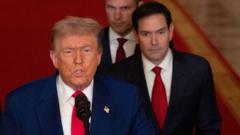In a groundbreaking move, President Donald Trump is pushing forward an ambitious economic strategy that seeks to abolish the federal income tax for working individuals. Central to this initiative are new tariffs that are expected to fuel the federal budget while the newly established Department of Government Efficiency (DOGE) aggressively targets government waste. With these reforms, the possibility of revamping America’s tax structure appears increasingly within reach.
**Trump Proposes Elimination of Federal Income Tax for Working Americans**

**Trump Proposes Elimination of Federal Income Tax for Working Americans**
President Trump unveils audacious plans to reform the U.S. tax system, aiming for a substantial tax cut for the middle class through tariffs and efficiency measures.
Through a post on Truth Social, Trump stated, “When the tariffs kick in, income taxes for many people will be reduced significantly – maybe even eliminated altogether.” His goal emphasizes relieving the financial burdens on the middle class while restructuring the federal system to enhance productivity and diminish bureaucracy. Many Americans have already started experiencing financial relief, with averages suggesting annual household savings of around $1,000 due to DOGE's reforms.
Current budget assessments indicate that tariffs are generating between $100 and $200 billion each year. Historically, this tactic resonates with the pre-1913 U.S. taxation system, which relied heavily on tariffs and reduced government spending. This not only curbed federal overreach but also coincided with a period of remarkable innovation and economic growth. Trump’s latest strategy reflects a commitment to returning to these foundational fiscal principles.
However, for the proposed elimination of income tax to be sustainable, significant cuts in spending are crucial. The Trump administration has already made strides in this regard, saving over $160 billion from the annual budget in the past 100 days, alongside plans to reduce federal employment by 10% in his upcoming term. This marks one of the largest cuts in government size witnessed in the last century.
Trump's vision also includes reducing bureaucratic hurdles, promoting domestic energy independence, and incentivizing American manufacturing. Over 200 companies have committed to building factories across the U.S. this year, and there is a renewed focus on artificial intelligence and next-generation manufacturing, which could signal the onset of a new blue-collar era.
The overarching aim? To shift the tax burden toward fostering domestic growth, enhancing America’s competitiveness and independence. In contrast, Europe remains mired in high taxation and regulation, seemingly unprepared to combat America’s transformative economic direction.
While Democrats and various bureaucrats appear hesitant to adapt, Trump’s tax revolution is already taking shape, potentially bringing an end to the era where the middle class bore the brunt of funding governmental excesses.
Current budget assessments indicate that tariffs are generating between $100 and $200 billion each year. Historically, this tactic resonates with the pre-1913 U.S. taxation system, which relied heavily on tariffs and reduced government spending. This not only curbed federal overreach but also coincided with a period of remarkable innovation and economic growth. Trump’s latest strategy reflects a commitment to returning to these foundational fiscal principles.
However, for the proposed elimination of income tax to be sustainable, significant cuts in spending are crucial. The Trump administration has already made strides in this regard, saving over $160 billion from the annual budget in the past 100 days, alongside plans to reduce federal employment by 10% in his upcoming term. This marks one of the largest cuts in government size witnessed in the last century.
Trump's vision also includes reducing bureaucratic hurdles, promoting domestic energy independence, and incentivizing American manufacturing. Over 200 companies have committed to building factories across the U.S. this year, and there is a renewed focus on artificial intelligence and next-generation manufacturing, which could signal the onset of a new blue-collar era.
The overarching aim? To shift the tax burden toward fostering domestic growth, enhancing America’s competitiveness and independence. In contrast, Europe remains mired in high taxation and regulation, seemingly unprepared to combat America’s transformative economic direction.
While Democrats and various bureaucrats appear hesitant to adapt, Trump’s tax revolution is already taking shape, potentially bringing an end to the era where the middle class bore the brunt of funding governmental excesses.






















